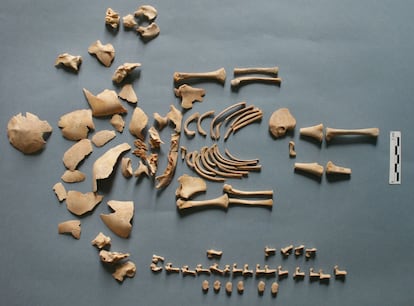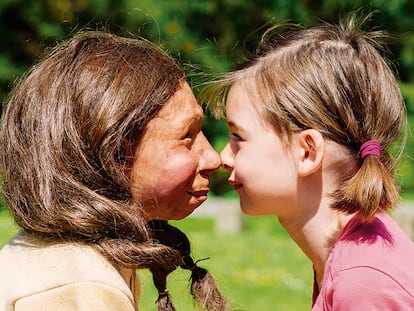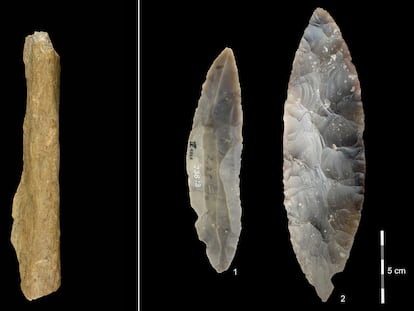The ancient inhabitants of northern Iberia carefully buried their children with trisomy 21
Genetic analysis of thousands of ancient DNA samples has found four cases of rare chromosomal mutations in sites in Navarra

More than 3,000 years ago, a new group of people arrived in the Ebro Valley. They came from the north and brought new funerary rites with them. They didn’t bury their dead, they cremated them. But the excavation of several sites in recent decades has found very young children buried under the floor of houses. From their bone analysis, it was suspected that they had some form of skeletal pathology.
Now, a review based on a new method of analyzing ancient DNA has found chromosomal abnormalities in four of them. Statistically and demographically, such a number is impossible, which leads the authors of the discovery to maintain that “ancient societies likely acknowledged these individuals as members of their communities” and “the burials of the individuals were either special, or performed with care according to standard practices.”
A few years ago, scientists from the Max Planck Institute for Evolutionary Anthropology (MPG, Germany) embarked on an ambitious project that involved searching their enormous database of DNA from ancient humans for the presence of any of the chromosomal trisomies. In such conditions, cells carry three copies of a particular chromosome instead of two: one inherited from each parent.
Of the 23 chromosomes, there are only three non-fatal trisomies: trisomy 21 (which manifests in what is popularly known as Down syndrome), the rare trisomy 18 (Edwards syndrome), and the even rarer trisomy 13 (Patau syndrome). Given the relatively low prevalence of the syndromes in the population, the scientists needed as many genetic samples as possible from the past. They managed to collect genetic data from 9,855 people who lived between about 5,000 and 400 years ago. Of these, 37 came from young children from two sites in the south of the Navarra region of Spain. The bones had already been analyzed at the beginning of the century, but at that time there was no technology to sequence ancient DNA.
Adam Rohrlach, the lead author of the research that has been published in Nature Communications describes the new method his team used: “We look at the percentage of DNA in a sample that comes from each of the chromosomes and compare it with all the other samples that we have”. Next, “we sought to identify those that had approximately 50% more DNA mapping on chromosome 18 or 21, which would indicate an additional copy of the chromosome for an individual,” the scientist at MPG and the University of Adelaide (Australia) explains.
With this system, they found seven cases of trisomy among the 9,855 samples they analyzed. They are all very young children. The most recent burial was unearthed in a Christian cemetery in Helsinki (Finland) and dates from the 17th century. The two oldest are from a site in Bulgaria, where they found a six-month-old girl who lived about 4,900 years ago, and the other was from Mycenaean Greece, from which they had samples of another girl of about 12 months of age, who died about 3,300 years ago. The other four come from Spain. Three are from the Alto de la Cruz excavation in the Navarra region, and one child was found at Las Eretas, another site in Navarra. The four set of remains are between 2,800 and 2,400 years old.

“Although we have a collection of samples from all over the world, the types of samples from some areas are not comparable to those from others,” says Kay Prüfer, a Planck Institute scientist who coordinated the analysis of the sequences. “In particular, the two Spanish sites in our study only have burials of children. This was not normal in the other places where we collected samples,” the professor adds. “Given the short life expectancy of people with trisomies in the past, this means we are less likely to find cases where we primarily collect adults. But, in the end, trisomy is so rare that chance also plays an important role,” she concludes in an email.
Chance does not seem to fit in the case of the children from the sites in Navarra. They belong to the towns of the so-called Urnfield culture. And they were called that because, because what has been best preserved of them are that, urns with remains of humans cremated in necropolises. Unlike the previous settlers, who buried their dead, these people of probable Indo-European origin cremated their deceased. “But not all of them. Infants were buried in their homes, as if their parents wanted to keep the family together,” the archaeologist from the Autonomous University of Barcelona and co-author of the study, Roberto Risch, points out.
But it still doesn’t fit. On the one hand, these towns were inhabited for about five centuries. Given the high infant mortality in the past, if the custom was to bury all newborns or deceased babies, there should be many more than those that have been found. Risch maintains that they must have had something special, something that made them different. Since he obtained his degree in the 1980s, this scientist was always intrigued by this very particular funeral ritual. Now, the study of their DNA seems to have proved him right. “These were small communities of 100 to 200 individuals. Given the prevalence of trisomies [in the case of trisomy 21, there is one for every 705 births], more than 1,000 births would have had to occur. “It is statistically impossible,” he says. For him, the only explanation is that they reserved the honor of being buried within the walls, under their houses, for the children who had something different.
“Even if they were stillborn or died shortly after birth, they received special treatment. By burying them under the floor, they returned to the family environment”Patxuka de Miguel, physical anthropologist at the University of Alicante and midwife at Alcoy hospital
Patxuka de Miguel is a physical anthropologist at the University of Alicante. She participated in the first analysis of these children’s bones almost 20 years ago together with Javier Armendáriz, the archaeologist from the Public University of Navarra, and both are co-authors of this new study. Even then, they saw that in some cases the bones had abnormalities. This is the case of a 40-week old infant who was found in Alto de la Cruz. But back then there were no genetic tools.
Now it has been learned that he had trisomy 18, also known as Edwards syndrome. This genetic alteration manifests itself in microcephaly, eye and mouth malformations, and clenched hands. “There were malformations in the bones compatible with the syndrome. Now there is no longer any doubt,” he says. This is the oldest case of trisomy 18 discovered so far. De Miguel agrees with Risch: “Even if they were stillborn or died shortly after birth, they received special treatment. By burying them under the floor, they returned to the family environment.”
Archaeologist Armendáriz recalls that, until the last century, it was common in Navarra and the Basque Country to bury deceased newborns before they had been baptized. This prevented them from being buried in a cemetery, and the deceased child was commonly interred in the eaves of their home. “It may be a practice that comes from then,” he says. Remember that 3,000 years ago the funeral ritual for the general population was cremation. “We don’t have skeletons from then, except for those of these children,” he says. “Not all of them were buried in the houses, but those who were buried were perfectly buried, and some had a trousseau,” he adds. The same had happened with the two sets of remains from Bulgaria and Greece. With no obvious relationship with the children of Navarra, they were also buried within the walls of their homes.
The idea of a special and selective burial does not convince Antonio Salas Ellacuriaga, a researcher in Population Genetics in Biomedicine at the Health Research Institute of Santiago de Compostela. In statements to SMC Spain, he argues: “The most obvious limitation, from my perspective, lies in the need to interpret society’s perception of people affected by syndromes based on how they were buried.” For him, the burial ritual offers only a partial perspective of history. “In addition, given that all the cases the have been identified correspond to early age stages (perinates/neonates/infants), there is the possibility that these individuals had not yet developed distinctive features,” the also professor at the Faculty of Medicine at the University of Santiago de Compostela adds, although he did not participated in the study.
However, De Miguel, who in addition to being an anthropologist also works as a midwife at the Verge dels Lliris Hospital in Alcoi (Alicante), maintains that “many of the signs of trisomy are visible and identifiable in newborns, especially after the first cry.” What happened to them? Armendáriz points out a possibility: “In the Urnfield culture they would have been treated like others, and like the adults, they would have been cremated.”
Between the two sites in this study and the one at Castejón de Bargota (also in Navarra), which does not feature because the scientists did not find children with trisomy, scientists found the remains of 53 children. And they have identified only four with this chromosomal abnormality. To determine with certainty that each of them had something that made them special enough to be buried rather than cremated, the authors say that further research will be needed “to form hypotheses on the cultural practices that may have led to this.”
Sign up for our weekly newsletter to get more English-language news coverage from EL PAÍS USA Edition
Tu suscripción se está usando en otro dispositivo
¿Quieres añadir otro usuario a tu suscripción?
Si continúas leyendo en este dispositivo, no se podrá leer en el otro.
FlechaTu suscripción se está usando en otro dispositivo y solo puedes acceder a EL PAÍS desde un dispositivo a la vez.
Si quieres compartir tu cuenta, cambia tu suscripción a la modalidad Premium, así podrás añadir otro usuario. Cada uno accederá con su propia cuenta de email, lo que os permitirá personalizar vuestra experiencia en EL PAÍS.
¿Tienes una suscripción de empresa? Accede aquí para contratar más cuentas.
En el caso de no saber quién está usando tu cuenta, te recomendamos cambiar tu contraseña aquí.
Si decides continuar compartiendo tu cuenta, este mensaje se mostrará en tu dispositivo y en el de la otra persona que está usando tu cuenta de forma indefinida, afectando a tu experiencia de lectura. Puedes consultar aquí los términos y condiciones de la suscripción digital.
More information
Archived In
Últimas noticias
Most viewed
- Sinaloa Cartel war is taking its toll on Los Chapitos
- Oona Chaplin: ‘I told James Cameron that I was living in a treehouse and starting a permaculture project with a friend’
- Reinhard Genzel, Nobel laureate in physics: ‘One-minute videos will never give you the truth’
- Why the price of coffee has skyrocketed: from Brazilian plantations to specialty coffee houses
- Silver prices are going crazy: This is what’s fueling the rally











































